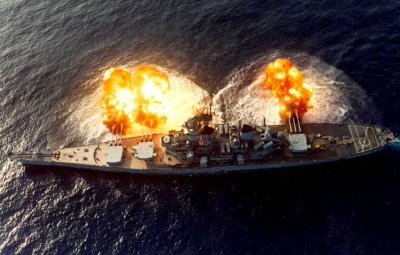click picture to enlarge
 United States Naval Warship BATTLESHIP NEW JERSEY BB-62
United States Naval Warship BATTLESHIP NEW JERSEY BB-62
Save the battlewagons
Oliver North
April 15, 2005
"There is no weapon system in the world that comes even close to the visible symbol of enormous power represented by the battleship." -- Retired Gen. P.X. Kelly, USMC WASHINGTON, D.C. -- Those words of the former Marine commandant resonate with me. In 1969, gunfire from the battleship USS New Jersey (BB-62) saved my rifle platoon in Vietnam. During her six months in-theater, the USS New Jersey's 16-inch guns were credited with saving more than 1,000 Marines' lives.
The North Vietnamese so feared the ship that they cited her as a roadblock to the Paris peace talks. Our leaders, as they did so often in that war, made the wrong choice and sent her home. Now, 36 years later, Washington is poised to make another battleship blunder.After the USS Iowa (BB-61) and USS Wisconsin, (BB-64) were taken out of active service in 1992, Congress passed Public Law 104-106, a 1996 measure requiring that our last two battleships be kept ready for reactivation. But today's Navy brass wants Congress to repeal the law, strike the ships from Naval Vessel Register -- the official list of available ships -- and donate them to museums. The Navy, focusing on a new "strategic vision" called "sea basing," claims that the battleships' proven firepower is no longer necessary for Naval Gun Fire Support (NGFS) -- the kind of mission that saved my Marines three decades ago.
Adm. Vernon Clark, the chief of naval operations, says that "Marines will be supported by combat air." That's great -- except when bad weather keeps the planes on deck instead of overhead. It also ignores the full range of support that is economically available from well-protected, highly mobile, gun and missile-firing battleships. This is not your grandfather's battlewagon. In 1983, the USS New Jersey was the best support available to the Marines after their barracks were bombed in Beirut. During the "tanker war," in the mid-1980s, every time the USS Iowa steamed into the Persian Gulf, the Iranians ceased hostile action. During Desert Storm, cruise missiles launched from both the USS Missouri (BB-63) and the USS Wisconsin attacked scores of targets deep inside Iraq; and an entire Iraqi Naval Infantry unit surrendered to one of the USS Wisconsin's unmanned aerial vehicles. Unlike any other naval vessel, battleships combine survivability, speed and immediate, heavy firepower. The Navy claims that the "firepower problem" -- Marines call it "steel on target" -- will be solved by new, 5-inch Extended Range Guided Munitions (ERGM). Under development at great cost since 1996, the Government Accountability Office said in 2004 that the ERGM program is rife with cost overruns and that "its problems have led to test failures and delays." In truth, the ERGM should have been scrubbed in March 2000, when the Marines told Congress that neither ERGM nor any other 5-inch round would meet Marines' lethality requirements. Worse still, a May 2001 internal Navy report admitted that ERGM won't meet Marines' volume of fire requirements, either. Both needs can easily be met by existing 16-inch guns on the battleships.Navy planners insist that a new DD(X)-class of ships -- also still in development -- will surpass battleships' NGFS capabilities. But on April 1, 2003, Marine Commandant Gen. Michael Hagee testified that our nation's expeditionary forces "will remain at considerable risk" for want of NGFS until the DD(X) joins the fleet "in significant numbers." Since then, the Navy has reduced the DD(X) buy from 24 ships to five. This leaves Marines high and dry unless Iowa and Wisconsin are available for rapid reactivation. Even if the Navy ordered more of the DD(X) class -- at $2 billion to $3.5 billion each -- these small, thin-skinned vessels are highly vulnerable to "sea skimmer" missiles. And a terrorist action, like the 2000 attack on the USS Cole -- which crippled the destroyer and killed 17 -- would do similar damage to a DD(X). Naval officers admit that heavily armored battleships are practically impervious to such strikes, but claim that what the DD(X) lacks in armor it will make up in stealth and speed. To embattled Marines that just means their nearest naval gunfire support will be far out at sea and traveling at high speed -- neither of which contribute to accurate "steel on target" for troops fighting ashore. Our Navy currently has no capability for providing the lethal, high-volume firepower that would be required if -- God forbid -- we should have to land Marines on the coasts of Iran or North Korea, or in defense of Taiwan.
When the Marines assaulted Um Qasr at the start of Operation Iraqi Freedom in March 2003, they had to rely on naval gunfire from an Australian frigate.
The Navy's answer is to wait six years for the costly, unproven ERGM system and a half-dozen or fewer, yet-to-be-built DD(X) ships. But America's enemies may not wait that long. And America's taxpayers may not want to pay the price -- in blood or treasure. The DD(X)-ERGM experiments are estimated to cost between $12 billion and $16 billion. It would take less than two years to reactivate the Iowa and Wisconsin. The battleships are 10 percent faster than the still-conceptual DD(X). They each bring to bear 12 5-inch and nine 16-inch guns -- capable, with new munitions, of firing accurately to nearly 100 miles. The two battleships can also carry nearly twice as many cruise missiles as all the DD(X) hulls combined. All that firepower is available for $2 billion -- the cost of one DD(X). Sometimes, as I tell my grandchildren, older is better. In the case of the two battlewagons, older is not only superior, it's also a lot less expensive.Oliver North is a nationally syndicated columnist and the founder and honorary chairman of Freedom Alliance.====
EXTERNAL LINK



